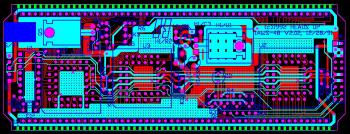-
Audio annunciations are provided in addition to visual annunciations.
For example, in case of a battery over-temperature condition, the red "BATT
O'TEMP" light is lit and the pilot hears "BATTERY OVERTEMP!".
Actually, many of the audio annunciations are somewhat more complex, repeating
a certain number of times with certain delays in between, and/or being
preceded by alert-tones.
-
The behaviors of the visual annunciators are actually much more complex
than described. For example, most lights begin flashing when
first activated, then become lit steadily when an external reset button
is pressed, and then finally become dark when their activating signals
are removed. Many of the lights are much more complex than this,
with built-in delays upon being activated or deactivated, being activated
or deactivated only upon certain combinations of signals, etc.
-
Because of the important functionality provided by the unit, a certain
level of redundancy is provided by separating the audio and video annunciations
into two separate CPUs.
-
The visual annunciations aren't really light bulbs, but are actually complex
sandwiches of custom LCDs with LEDs to provide reliability with both day
and night visibility.
-
The electrical signals used to activate the annunciations aren't simple
identical on/off signals. Each differs from the next, with programmable
polarity and voltage ceilings/floors. Some signals are actually active
only when pulsing.
This product has proved very important to Heads Up, and at this
writing (about 10 years after the initial product introduction) is sold
in roughly the same quantities as when first introduced. Many variations
of the product have been requested by Cessna, and continue to be introduced
approximately every 6 months.
The initial development of the IAWS was also signficant in terms of
its "firsts" and its consequences:
-
In spite of the complexity of the product (9 circuit boards, 3-CPU design
with 3 separate sets of firmware), I was forced to design the product on
a very ambitious schedule, with no break between it and the design cycle
for the preceding product. The prototyping
phase took about 4 months.
-
Documentation requirements for Cessna necessitated the invention of the
Heads Up "drawing package" system, an internal engineering system that
had not previously existed in any satisfactory sense, but took the manufacturing
and engineering documentation of our products to a much higher level that
had previously existed. I contributed heavily to this system, and
all subsequent replacement drawing-package systems were essentially my
personal inventions.
-
This was by far the most complex design that I (or Heads Up) had created
at that time.
-
I carefully crafted the firmware and hardware to be very reconfigurable,
and to interact heavily with PC-based diagnostic software. Because
Cessna's requirements for the product were quite variable at the beginning,
these characteristics came to our aid on several occasions to drastically
reduce re-design time, and to give Cessna the impression that Heads Up's
engineering was extraordinarily responsive. This has contributed
to the highly favorable position (in terms of new business) which Heads
Up has since enjoyed with Cessna.



















